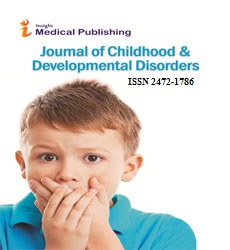A commentary on Down syndrome
Arita Chan W.Y
DOI10.36648/2472-1786.21.7.30
Arita Chan W.Y*
Department of Psychology, The Education University of Hong Kong, Hong Kong
- Corresponding Author:
- Arita Chan WY, Department of Psychology, Tel: +852 2948 8888; E-mail: kkschan@eduhk.hk
Citation: Arita Chan WY (2021) A Commentary on Down syndrome. J Child Dev Disord. Vol.7 No.6.
Received date: June 08, 2021; Accepted date: June 22, 2021; Published date: June 29, 2021
Abstract
Commentary
Down syndrome is a condition in which a person has an extra chromosome. Chromosomes are small “packages” of genes in the body. They determine how a baby’s body forms and functions as it grows during pregnancy and after birth. Typically, a baby is born with 46 chromosomes. Babies with Down syndrome have an extra copy of one of these chromosomes, chromosome 21. A medical term for having an extra copy of a chromosome is ‘trisomy.’ Down syndrome is also referred to as Trisomy 21. This extra copy changes how the baby’s body and brain develop, which can cause both mental and physical challenges for the baby.
Each person with Down syndrome is an individual — intellectual and developmental problems may be mild, moderate or severe. Some people are healthy while others have significant health problems such as serious heart defects.
Children and adults with Down syndrome have distinct facial features. Though not all people with Down syndrome have the same features, some of the more common features include:
• Flattened face, Small head, Short neck, Protruding tongue
• Upward slanting eye lids (palpebral fissures), Unusually shaped or small ears
• Poor muscle tone, Broad, short hands with a single crease in the palm
• Relatively short fingers and small hands and feet, Excessive flexibility, Tiny white spots on the colored part (iris) of the eye called Brush field’s spots, Short height
Infants with Down syndrome may be average size, but typically they grow slowly and remain shorter than other children the same age.
Symptoms
• A flattened face, especially the bridge of the nose.
• Almond-shaped eyes that slant up, a short neck.
• Small ears, a tongue that tends to stick out of the mouth.
• Tiny white spots on the iris (colored part) of the eye.
• Small hands and feet, a single line across the palm of the hand (palmar crease).
• Small pinky fingers that sometimes curve toward the thumb.
• Poor muscle tone or loose joints, Shorter in height as children and adults.
Diagnostic Tests
If the screening test results positive, the following options are available:
• Diagnostic test by chorionic villus sampling (CVS) performed between 10-13 weeks,
• Diagnostic tests by amniocentesis are performed after 15 weeks
• Second-trimester maternal serum is drawn for screening after 15 weeks and a result combining first, and secondtrimester is obtained
• Detailed anatomy ultrasound is performed at approximately 18-20 weeks.
Diagnostic tests such as CVS and amniocentesis can tell you whether or not a baby has a chromosome abnormality with more than 99% accuracy. While the final results of the chromosomal analysis may take 2-3 weeks, interim results may be available in a few days.
Couples or individuals may elect not to proceed with additional tests for various reasons. They may be comfortable with the results irrespective of the outcome or may choose to avoid any testing that poses a potential risk of harming the developing baby. It is important to discuss the risks and benefits of testing thoroughly with your doctor.
Frequency
Down syndrome occurs in about 1 in 700 newborns. About 5,300 babies with Down syndrome are born in the United States each year, and approximately 200,000 people in this country have the condition. Although women of any age can have a child with Down syndrome, the chance of having a child with this condition increases as a woman gets older.
Causes
Most cases of Down syndrome result from trisomy 21, which means each cell in the body has three copies of chromosome 21 instead of the usual two copies.
A very small percentage of people with Down syndrome have an extra copy of chromosome 21 in only some of the body's cells. In these people, the condition is called mosaic Down syndrome.
Researchers believe that having extra copies of genes on chromosome 21 disrupts the course of normal development, causing the characteristic features of Down syndrome and the increased risk of health problems associated with this condition.
Conclusion
Down syndrome is a common genetic disorder with multisystem involvement. Congenital heart diseases, hypothyroidism and recurrent respiratory infections were the common medical problems identified in this study. Proper health education and provision for checklist-based screening for medical problems should be instituted for structured and comprehensive health care program for these special children. This certainly will improve their health status and as well as the quality of life.
Open Access Journals
- Aquaculture & Veterinary Science
- Chemistry & Chemical Sciences
- Clinical Sciences
- Engineering
- General Science
- Genetics & Molecular Biology
- Health Care & Nursing
- Immunology & Microbiology
- Materials Science
- Mathematics & Physics
- Medical Sciences
- Neurology & Psychiatry
- Oncology & Cancer Science
- Pharmaceutical Sciences
